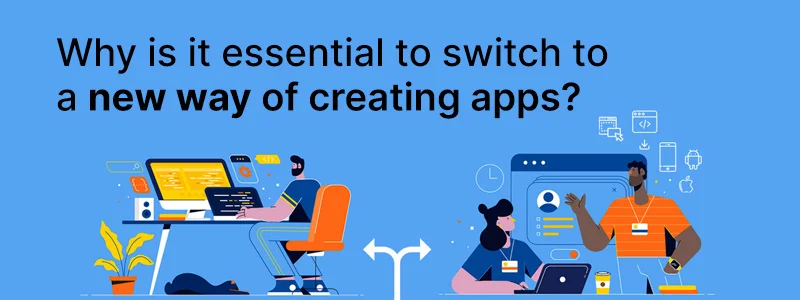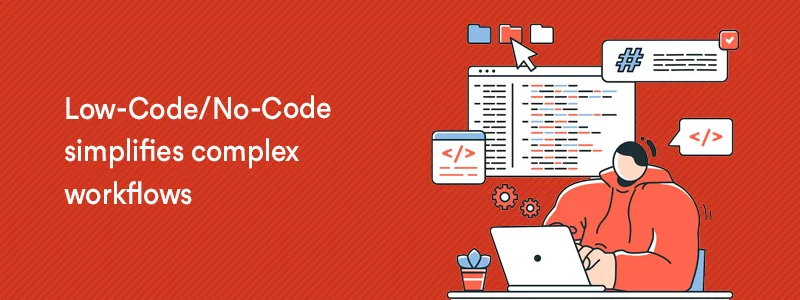
Is low code going to change the future of Android & iOS app development?
A few years ago, developers with the required skills and coding knowledge were used to build an app, and it is an expensive & time-consuming task. But today, many low code app development platforms allow users to create their own interactive and feature-rich apps. A few years later, we will look back to the old days and remember how we relied on professional coders for simple application development. Without worrying about the cost or infrastructure, anyone can build an app using low code; one thing you need to have is an internet connection.
One of the significant factors that affect today’s business is digital transformation. Companies rely on digital solutions to provide improved solutions for customers. This need leads to a growing demand for low-code development platforms across the world. Using the low code platform features such as drag & drop components and visual modeling, developers gain a different experience in creating mobile and web applications. Due to the increase in smartphones usage and rapid economic growth, the demand for low code platforms is expected to increase in the future. According to expert research, a low code platform is the future of application development. But it is not going to replace professional developers.
Why is pro code required?
Pro code is unavoidable because there is no single logic method to cover all application development scenarios and conditions. Professional developers are required to build a secure infrastructure with a sophisticated user interface. The problem arises when a low code platform needs to modify or change something that has been included in the existing components.
Skilled developers are needed to develop a large-scale enterprise application, said Thomas Stiehm, CTO of Coveros, an Agile and DevOps consultancy. Low code development platforms have a firm place in the future because they reduce the complexity of building applications, but they won’t replace other ways of creating applications. The developers need a rudimentary knowledge of programming language to create an app using low code platforms. In a large-scale business, low code take-up is limited due to the lack of extra time for support, oversight, and maintenance.
Low code mobile app creator tools do not support all the functions that business needs, and this is to be done by professional developers. The researchers predict that the low-code application platform market will rise from $4.32billion in 2017 to $27.73 billion by 2022.
Source: Research and Markets (Global Low-Code Development Platform Market 2017-2022)
If we get something instantly, we have to compromise with the quality of the services or products we receive. Let’s now look at the pitfall of the low code development:
- Problems in integration with the existing business systems
- Do not support some functionality you need
- There is a limit in extending the custom code in low code apps
- Due to platform restrictions, you are forced to drop certain functionality and features
- You cannot control your application when you depend on a third-party platform
When anything goes wrong, there needs to be a code developer to fix the issue. There are many automation tools to create an app without coding. But it still needs professional developers to ensure it is built correctly. Developers do not prefer a low code development platform to deliver a high-quality application.
The central theme of low code development is anyone can build an application. But everyone thinks it is a false postulation. Try sterlo to discover the truth! With the introduction of our low-code mobile app development platform, we have torn down these obstacles and debunked misleading assumptions.
Balanced mix of pro code and low code
Obtain a better solution with full-stack and business users’ expertise by enabling smooth collaboration between pro code and low code. You can easily access data when you permit the full stack developers to produce intermediate services that show the main API features. You can increase the efficiency of the cross-function team by combining pro code and low code.
Low code platform vendors recommend using full-stack coding to accomplish the complex business logic. Low code development platforms allow the full stack developer and IT architects to consume data from any database and revamp the data streams. It also combines professional pro code and low code, which helps drive corporate innovation and deliver unique digital products for the end-user. Inject pro code and finally unlock the power of low code.
Why use low-code platforms to deploy apps?
Low code platforms are used to create an application with less coding that is ten times faster than building code from scratch. It acts as a bridge between business and IT that enables rapid business application delivery. Developing applications using low code platforms is the same way as building applications using pro code; the only difference is dragging & dropping display modules of the existing code and shortcuts. It simplifies using a graphical user interface (GUI) for connecting and testing components and third-party application program interfaces (APIs).
Rapid distribution and continuous improvement are two of the most important reasons for the low-code development model. It allows you to deploy apps simultaneously on Android and iOS devices.
Using low code, professional developers can build applications faster and smarter because they are not hamstrung by redundant coding. To complete the big projects, you no longer have to wait for professionally skilled developers, which means things can be done with non-technical developers at a low cost. With the low code, a single click is required to deploy the application. Once the application is developed, no longer wait for the launch.
Using APIs in the low code environment
Every application has to rely on other applications to access data or complete tasks in today’s business. Application program interface (API) is a way to integrate your application and other applications. Rather than depending on the large code, API allows the consistent data flow between applications and adds more functionalities. It only focuses on sharing specific information does not know how the other application works.
For example, if you use any e-commerce applications, you will use a payment app such as GPay or PhonePe to complete your purchase. Here, API provides secure integration between e-commerce and payment applications. It uses three types of authentication for a secure connection: HTTP, API key, and OAuth. Without APIs, the development process slows down because different teams build different solutions to access the organization’s data.
Using APIs, one can simplify the interaction between internal & third-party applications and eliminate extensive code writing. Both the API and low code platform aim is to speed up the development process by reducing the time and cost.
Solving integration issues is one of the many arenas in which low-code platforms can shine. Most low code platforms have pre-built and custom APIs to provide secure integration between different applications. Low code platforms manage data and expose APIs that improve visibility and extensibility. With end-to-end API integration, interconnect applications for enhancing the efficiency of the business.
API integration services:
- Single platform for connecting & controlling third-party data
- Automate the business process
- Periodic update of connection between applications
- Quick implementation of connection
- Compatible with multi-cloud providers
- Provide customized services to satisfy business needs
Need to know how to code?
Coding knowledge is required when extending the application with custom code and fixing the issues. Professional and non-technical developers can build applications that increase business productivity using low code platforms. According to a study, 66% of low code development platform users are professional developers from an enterprise IT department. Coding knowledge is essential to deal with complex functionality. Instead of becoming a complete developer, one can build an application just by learning a few hacks and shortcodes.
Reduce dependency on pro code developers
Building large applications involve writing hard code, compiling, and linking many source code files. Non-technical developers cannot do this process. Low-code development platforms are introduced to reduce the dependency on professional developers. It incorporates model-driven design, automatic code generation, and visual modeling and these features break the myth of the demand for pro code developers. In the future, the implementation of automation in application development can lead to developers’ complete replacement. Most low code platforms fail to have fine-grain control over exactly how the user interface renders.
sterlo low code app development platform enables your business and IT to work together to align their visions and turn them into effective business apps. Not just professional developers, anyone can create and design apps that appear and function exactly how they want them to. Eliminate the need for your teams to maintain a separate tech stack. Meeting market growth expectations, streamlining processes, and speeding up digital transformation are all possible with sterlo.
In our platform, you can use visual interfaces with simple logic and drag-and-drop capabilities instead of complex programming languages. Visual modeling features in sterlo represent the intricate details in a way that anyone can understand – from non-technical business users to advanced engineers.
We are transforming the software development world by reducing the learning curve and making software creation easier, faster, and more accessible. Low-code iOS and android app builder platforms may not have all the answers, but they show how to simplify and shorten certain stages of software development. But of course, your organization can innovate and respond to dynamically changing business environments at a faster rate with our low-code app development services.


